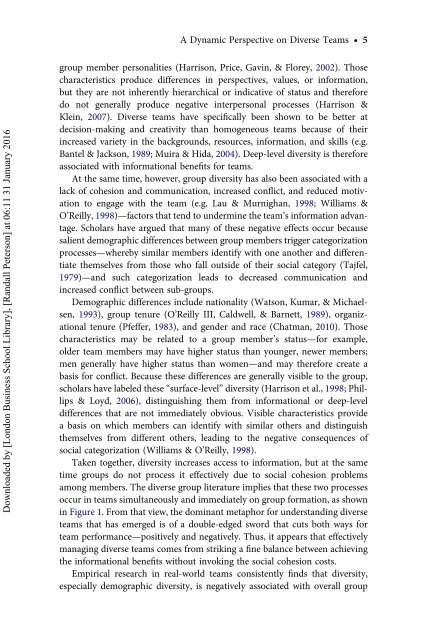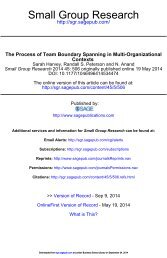A Dynamic Perspective on Diverse Teams: Moving From The Dual Process Model to A Dynamic Coordination-Based Model of Diverse Team Performance - Kannan Srikanth, Sarah Harvey & Randall Peterson
The existing literature on diverse teams suggests that diversity is both helpful to teams in making more information available and encouraging creativity and damaging to teams in reducing cohesion and information sharing. Thus the extant literature suggests that diversity within teams is a double-edged sword that leads to both positive and negative effects simultaneously.
The existing literature on diverse teams suggests that diversity is both helpful to teams in making more information available and encouraging creativity and
damaging to teams in reducing cohesion and information sharing. Thus the
extant literature suggests that diversity within teams is a double-edged sword
that leads to both positive and negative effects simultaneously.
You also want an ePaper? Increase the reach of your titles
YUMPU automatically turns print PDFs into web optimized ePapers that Google loves.
A <str<strong>on</strong>g>Dynamic</str<strong>on</strong>g> <str<strong>on</strong>g>Perspective</str<strong>on</strong>g> <strong>on</strong> <strong>Diverse</strong> <strong><strong>Team</strong>s</strong> † 5<br />
Downloaded by [L<strong>on</strong>d<strong>on</strong> Business School Library], [<strong>Randall</strong> Peters<strong>on</strong>] at 06:11 31 January 2016<br />
group member pers<strong>on</strong>alities (Harris<strong>on</strong>, Price, Gavin, & Florey, 2002). Those<br />
characteristics produce differences in perspectives, values, or informati<strong>on</strong>,<br />
but they are not inherently hierarchical or indicative <strong>of</strong> status and therefore<br />
do not generally produce negative interpers<strong>on</strong>al processes (Harris<strong>on</strong> &<br />
Klein, 2007). <strong>Diverse</strong> teams have specifically been shown <strong>to</strong> be better at<br />
decisi<strong>on</strong>-making and creativity than homogeneous teams because <strong>of</strong> their<br />
increased variety in the backgrounds, resources, informati<strong>on</strong>, and skills (e.g.<br />
Bantel & Jacks<strong>on</strong>, 1989; Muira & Hida, 2004). Deep-level diversity is therefore<br />
associated with informati<strong>on</strong>al benefits for teams.<br />
At the same time, however, group diversity has also been associated with a<br />
lack <strong>of</strong> cohesi<strong>on</strong> and communicati<strong>on</strong>, increased c<strong>on</strong>flict, and reduced motivati<strong>on</strong><br />
<strong>to</strong> engage with the team (e.g. Lau & Murnighan, 1998; Williams &<br />
O’Reilly, 1998)—fac<strong>to</strong>rs that tend <strong>to</strong> undermine the team’s informati<strong>on</strong> advantage.<br />
Scholars have argued that many <strong>of</strong> these negative effects occur because<br />
salient demographic differences between group members trigger categorizati<strong>on</strong><br />
processes—whereby similar members identify with <strong>on</strong>e another and differentiate<br />
themselves from those who fall outside <strong>of</strong> their social category (Tajfel,<br />
1979)—and such categorizati<strong>on</strong> leads <strong>to</strong> decreased communicati<strong>on</strong> and<br />
increased c<strong>on</strong>flict between sub-groups.<br />
Demographic differences include nati<strong>on</strong>ality (Wats<strong>on</strong>, Kumar, & Michaelsen,<br />
1993), group tenure (O’Reilly III, Caldwell, & Barnett, 1989), organizati<strong>on</strong>al<br />
tenure (Pfeffer, 1983), and gender and race (Chatman, 2010). Those<br />
characteristics may be related <strong>to</strong> a group member’s status—for example,<br />
older team members may have higher status than younger, newer members;<br />
men generally have higher status than women—and may therefore create a<br />
basis for c<strong>on</strong>flict. Because these differences are generally visible <strong>to</strong> the group,<br />
scholars have labeled these “surface-level” diversity (Harris<strong>on</strong> et al., 1998; Phillips<br />
& Loyd, 2006), distinguishing them from informati<strong>on</strong>al or deep-level<br />
differences that are not immediately obvious. Visible characteristics provide<br />
a basis <strong>on</strong> which members can identify with similar others and distinguish<br />
themselves from different others, leading <strong>to</strong> the negative c<strong>on</strong>sequences <strong>of</strong><br />
social categorizati<strong>on</strong> (Williams & O’Reilly, 1998).<br />
Taken <strong>to</strong>gether, diversity increases access <strong>to</strong> informati<strong>on</strong>, but at the same<br />
time groups do not process it effectively due <strong>to</strong> social cohesi<strong>on</strong> problems<br />
am<strong>on</strong>g members. <strong>The</strong> diverse group literature implies that these two processes<br />
occur in teams simultaneously and immediately <strong>on</strong> group formati<strong>on</strong>, as shown<br />
in Figure 1. <strong>From</strong> that view, the dominant metaphor for understanding diverse<br />
teams that has emerged is <strong>of</strong> a double-edged sword that cuts both ways for<br />
team performance—positively and negatively. Thus, it appears that effectively<br />
managing diverse teams comes from striking a fine balance between achieving<br />
the informati<strong>on</strong>al benefits without invoking the social cohesi<strong>on</strong> costs.<br />
Empirical research in real-world teams c<strong>on</strong>sistently finds that diversity,<br />
especially demographic diversity, is negatively associated with overall group
















